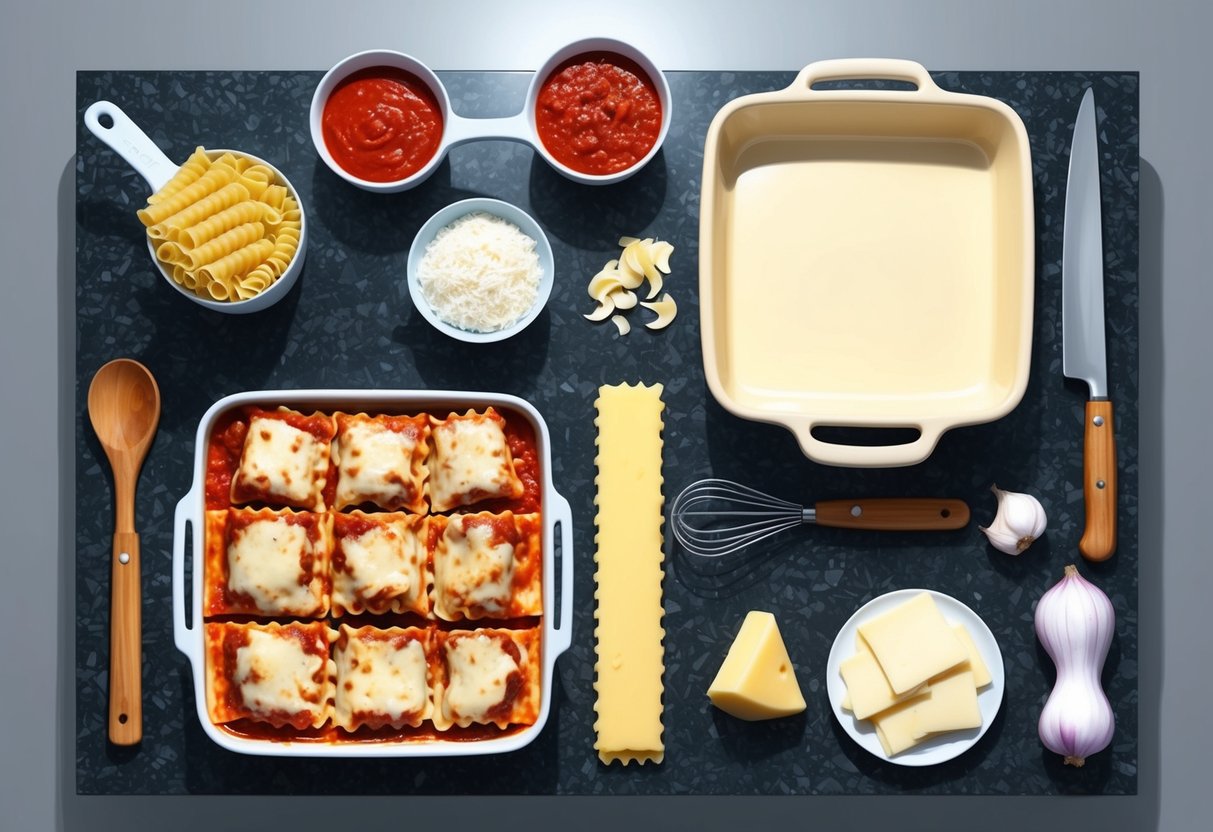
Layering Techniques for Restaurant-Quality Results
Achieving restaurant-quality lasagna depends on both the order of the layers and the care taken in spreading sauces, cheeses, and noodles.
A well-layered lasagna prevents dryness, promotes even cooking, and leads to the signature soft-yet-structured bite found in classic lasagna recipes.
Order of Layers and Composition
Building lasagna with the right sequence of layers creates balanced flavor and texture.
The process typically begins with a thin layer of tomato-based sauce on the bottom of the baking dish to prevent sticking and help cook the base noodles.
Next, uncooked or par-boiled lasagna noodles are placed in a single layer, ensuring they overlap slightly but do not pile up thickly.
Over the noodles, one spreads a mixture of ricotta cheese, beaten eggs, and grated parmesan cheese for a creamy, cohesive middle.
This is followed by a generous portion of meat sauce or ragù.
A layer of shredded mozzarella or grated cheese is then sprinkled over the top for richness.
These layers are repeated — sauce, noodles, ricotta mixture, meat sauce, grated cheese — until the dish reaches near the top of the pan.
The final layer should be a combination of sauce, extra mozzarella, and an ample dusting of grated parmesan for a browned, bubbly topping.
For more guidance, see tips on traditional lasagna layering methods and pro chef techniques.
Tips for Even Spreading and Thickness
Uniform layers are key in restaurant-quality lasagna.
Use a flat spatula or the back of a spoon to distribute each element evenly, especially sauces and cheese mixtures, reaching the dish’s corners to avoid dry spots.
Keep each cheese and filling layer about the same thickness to promote even baking and prevent sagging.
Do not overload any one layer — noodles should not be crowded or stacked too thickly, and each sauce layer should fully but lightly coat the previous layer.
Scatter grated cheese and shredded mozzarella evenly for consistent browning and flavor across the entire surface.
Allow the assembled lasagna to rest for several minutes after baking.
This helps layers set and makes clean slices possible.
For a detailed guide, check out Jamie Oliver’s tips on layering the perfect lasagna.
Assembling Your Lasagna Like an Italian Restaurant
Selecting the right tools and techniques is essential to create a lasagna that looks and tastes like it’s straight from a top Italian restaurant.
The baking dish and assembly methods transform layers of pasta, cheese, and sauce into a visually appealing and satisfying meal.
Choosing and Preparing the Baking Dish
A proper baking dish ensures even cooking and helps achieve the signature structure found in traditional lasagna.
A ceramic or glass rectangular pan, at least 9×13 inches (about 3-4 inches deep), is the preferred choice in restaurant settings.
Metal pans can cook unevenly and may react with acidic tomato sauces, so they’re best avoided.
Before assembling, lightly coat the bottom and sides of the dish with olive oil or a thin layer of sauce.
This keeps noodles from sticking and supports the classic stacked appearance.
Lay the first pasta sheet snugly along the bottom; some chefs slightly overlap pasta sheets for complete coverage, preventing sauce leakage.
Ensure each layer fills to the pan’s edges for straight, defined borders once sliced.
Use a ladle or large spoon to distribute sauce evenly, keeping the structure compact.
Proper preparation of the baking dish contributes to tidy layers and that signature restaurant-style presentation.
Techniques for an Attractive Finish
The top layer is what diners remember, so use care and attention for a polished appearance.
Finish with a generous layer of mozzarella and finely grated Parmigiano-Reggiano, covering the sauce and pasta right to the edges.
Add a few dabs of ricotta or bechamel for visual appeal and richness.
For a restaurant-quality golden finish, bake uncovered for the last 10–15 minutes.
Watch for bubbling around the edges and light browning on top.
Let the lasagna rest, uncovered, for about 20 minutes before slicing to keep layers intact and attractive.
Garnish with chopped basil or parsley for fresh color and a classic touch, as seen in professional recipes.
Use a sharp knife or metal spatula for clean slices that showcase the even layers and final presentation.
Lasagna Baking Times and Oven Settings
Proper baking is essential for restaurant-quality lasagna.
The right oven temperature, baking time, and clear visual cues help achieve tender pasta, thoroughly melted cheese, and flavorful browning every time.
Determining the Ideal Temperature
The ideal temperature for baking lasagna is consistently 375°F (190°C) in most recipes.
This temperature allows the noodles to cook evenly while preventing the cheese from burning.
Covered baking for most of the cooking time helps lock in moisture and ensures the center heats through.
Baking times may differ depending on the recipe and oven accuracy.
Most classic lasagna dishes require about 45–60 minutes of total bake time, which includes 30–40 minutes covered with foil and an additional 10–20 minutes uncovered to finish off the top.
For a breakdown, check a detailed homemade lasagna recipe.
Lasagna assembled directly from prep often needs a slightly longer cook, while reheated leftovers take less time.
Metrics for Doneness and Browning
Knowing when lasagna is done is key for optimal texture and presentation.
Fully cooked lasagna displays bubbling edges and a golden-brown cheese layer.
It should reach an internal temperature of 160°F (71°C) for food safety, which can be measured with a kitchen thermometer.
Remove foil during the last 10–15 minutes of baking to allow browning and crispness on the top cheese layer.
If a deeper color is desired, broil for 1–2 minutes, but watch closely to prevent burning.
Letting the lasagna rest for 10–15 minutes before serving ensures clean slices and better flavor distribution.
For visual guidance, visit this easy homemade lasagna guide which explains doneness cues.



